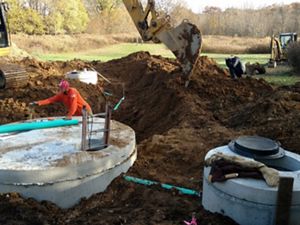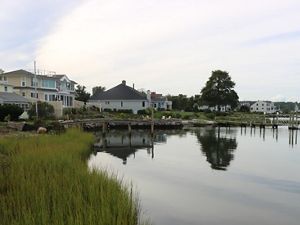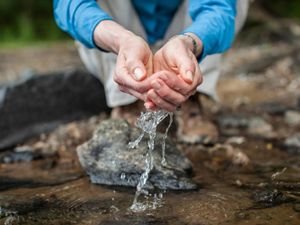Experimental Solutions to Reduce Nitrogen Pollution on Cape Cod
Too much nitrogen in our waterways threatens our drinking water, economy, recreation and human health. We are working with nature to change that.
The New England way of life depends on our water quality. Everything from our drinking water and food to recreation and the economy depends on healthy, clean water flowing from streams to our coasts and into the ocean. Unfortunately, the impacts of climate change and development are threatening the places we love and rely on. They are in danger of becoming over-polluted by nutrients like nitrogen and other chemicals that run off into rivers and estuaries. These excess nutrients lead to harmful algal blooms and widespread ecosystem destruction which threatens nature and coastal ways of life.
But there is hope. With innovative science, community partnerships, and on-the-ground research, The Nature Conservancy in Massachusetts is working to restore our coastal water systems from freshwater to saltwater and everything in-between, for the benefit of us all.
The Problem: Nitrogen Pollution
For many towns on Cape Cod, decades of nutrient pollution—especially nitrogen—in waterways from septic system effluent and fertilizer runoff threaten drinking water supplies and lead to toxic algae blooms, fish kills and beach closures.
Nitrogen is a key element in our natural systems and is essential for plant growth. But too much can be a bad thing. In our developed landscape, excess nitrogen from agriculture, home fertilizer use, and traditional septic systems that weren’t designed to remove nitrogen fuel the growth of plants like algae that out-compete beneficial plants and can be toxic to marine life and humans. Worse, elevated nitrate levels can be dangerous to human health, especially for children. When these excess nutrients flow into groundwater, they contaminate wells used for drinking water.

As the oceans absorb the increasing carbon dioxide and heat in our atmosphere, the waters warm and acidify, which stacks up the challenges for coastal ecosystems. Nutrient pollution-fueled algae blooms use up much of the oxygen in the water and add even more carbon dioxide—and the carbonic acid it produces—exacerbating stress on our waterways.
This damage isn’t just bad for the environment, it’s costly as well. Nitrogen-fueled algal blooms can close beaches, threatening a key income source for communities that rely on beachgoers and tourism. For families whose home wells are contaminated with nitrates, the costs of filtering or purchasing bottled water for drinking and cooking quickly add up. The consequences for marine health impact fisheries and aquaculture, a challenge for the seafood and tourism economies of these coastal towns.
What’s the innovative solution? Working with nature itself, with a little help from technology, too.
Quote: Alison Bowden

Nature can help address nitrogen pollution in our coastal waterways while also providing benefits for people. We need to scale these natural solutions for effective long-term results.
Nature is a Solution to Nitrogen Pollution
Nature-based solutions use natural features or processes, sometimes alongside manmade structures, to adapt to the impacts of climate change, enhance community resilience or improve water quality. In addition to addressing complex challenges, they often provide many other benefits, like wildlife habitat, flood protection, recreation opportunities, cost reductions and other community improvements. For example, restoring wetlands can help reduce stormwater flooding, filter pollutants to improve water quality and provide key habitat for fish, birds, amphibians—and nature lovers!

Nature vs. Nitrogen Pollution
To mitigate these nitrogen pollution challenges, we are advancing nature-based nutrient management solutions and exploring opportunities for innovative, long-term funding and financing to implement these fixes. TNC is working with multiple collaborators, including the Town of Barnstable, Barnstable Clean Water Coalition (BCWC), the Massachusetts Alternative Septic System Test Center (MASSTC) and the U.S. Environmental Protection Agency (EPA).
Traditional septic systems remove viruses and bacteria from wastewater but allow large quantities of nutrients and other contaminants to filter into groundwater and surface water supplies. Though many towns on Cape Cod are planning to expand their sewer networks, these plans will require billions of dollars and several decades to implement. TNC and BCWC, with support from EPA and the U.S. Geological Survey, conducted research and engaged with communities to identify nitrogen-reduction alternatives which help address the problem more quickly and cost-effectively. We are now piloting two of the most promising solutions in the Three Bays Watershed in Barnstable:
- Cranberry Bog Restoration: Restoring the Marstons Mills cranberry bog complex into an ecologically functional wetland designed to soak up nitrogen from water as it flows through the wetlands on its way to the Marstons Mills River and the ocean. In addition to traditional wetland restoration, the project includes a bioreactor, which uses woodchips to help remove additional nitrogen from the system.
- Innovative/Alternative (I/A) Septic Systems: Installing and monitoring the performance of woodchip-based alternatives which remove nitrogen far more effectively than traditional septic systems.
The results of these pilots will inform future steps and broader solutions in conjunction with the community.

Pilot Program: Restoring Cranberry Bogs and Enhancing Nitrogen Filtration
Much of the nitrogen polluting the Three Bays estuary flows through the Marston Mills cranberry bog complex. Restoring the natural wetland ecosystem processes that existed prior to cranberry cultivation will help filter out the nitrogen before it empties into Barnstable’s coastal waters. The wetlands will also improve wildlife habitat, carbon sequestration and recreational space for people.
In July 2020, a small-scale experiment designed to aid with nitrogen removal from the bog system was built in partnership with the bog owner, TNC, BCWC and EPA’s Office of Research and Development (ORD). This experiment filled part of a cranberry bog ditch at the head of the Marston Mills River with woodchips. Known as a bioreactor, this design has been used to remediate nutrient pollution in agricultural streams. Through this pilot, the team is learning valuable lessons to determine how bioreactors might be included in the ecological restoration to optimize nitrogen removal.

In early 2022, conceptual designs for the restoration were completed. These plans, designed by Inter-Fluve with input from the Native Land Conservancy, would restore Atlantic white cedar swamps on the site and would reshape channels and wetland habitats to enhance its ability to filter out excess nitrogen. Successful restoration of the area could provide 20% of the required nitrogen reduction in the watershed. The next phase of engineering design on the bogs is now underway and expected to be complete by fall 2023, supported by a five-year Pilot Watershed Initiative grant from EPA’s Southeast New England Program.
Mapping Septic Systems to Understand Impacts
TNC also helped develop a spatial tool that compiles data from local, state and county sources to build a model that anticipates the impact of I/A septic system installation. This map of septic systems in Barnstable considers a number of factors and can help TNC and the town prioritize where to invest in I/A systems, as well as what barriers and challenges we may need to work through.
How We’re Stopping Nitrogen at the Source
Catching nitrogen pollution on its way to the ocean is a critical step, but addressing the root cause is the most effective solution. In this case, the partially-filtered water—often still packed with nitrogen and other pollutants—released from septic systems is a big part of the problem, so it must be a part of the solution.
“Municipal sewer expansion has been the go-to method for source reduction,” says Casey Chatelain, Deputy Director of BCWC. “While it makes sense in densely developed areas, we need other tools in the toolbox for spread out areas where sewer can be costly and take decades to implement.”

Newer, enhanced I/A septic systems have been shown to successfully remove nitrogen in wastewater before it is released into the ground. Many of these systems rely on natural materials—like woodchips and limestone—as part of a system that hosts beneficial bacteria that turn nitrogen from the water into atmospheric nitrogen, which is much less of an issue in excess.
“Removing nitrogen using these next-generation septic systems can help us address these critical water quality concerns more quickly and affordably than sewer expansion in many places, but both are important tools,” says Emma Gildesgame, climate adaptation scientist for TNC in Massachusetts. “The hope is that systems which remove significant amounts of nitrogen will become the new standard for installation, leading to widespread adoption amongst the community. That’s where TNC and our partners come in.”

Barnstable Clean Water Coalition is piloting the replacement of traditional septic systems with these I/A systems. By Spring 2022, 14 homeowners in the Shubael Pond neighborhood were upgraded to these systems. EPA and partners are monitoring the resulting changes in groundwater nitrogen concentration for three years to determine the impacts of having them clustered in a single neighborhood.
In order to make pollution-removing septic systems the new normal, these new technologies must demonstrate that they meet the rigorous approval standards set by the Massachusetts Department of Environmental Protection. The Department is also proposing requiring better nitrogen reduction technologies in nitrogen sensitive areas, which includes much of Cape Cod, which could be promising for I/A system implementation.
Quote: Emma Gildesgame
The hope is that systems which remove significant amounts of nitrogen will become the new standard for installation, leading to widespread adoption amongst the community.
“Proving out these nature-based solutions will allow for wider spread adoption and faster water quality improvements not just in Barnstable, but across the region and for other coastal communities,” says Chatelain.
Gildesgame adds, “As we move to scale these projects, testing and demonstrating the value of nature-based alternatives to remove nitrogen will ensure the goals we build into funding mechanisms are appropriate and achievable.”

How do we pay for this?
Financing Nature-Based Solutions at Scale
Beyond understanding the efficacy of nature-based solutions and supporting the communities putting them into action, is also important to consider how to scale up and sustainably fund this strategy.
In 2020, the project partners, with help from Bain & Company consultants, conducted an impact investment feasibility study to determine how to secure sustainable long-term funding for nature-based solutions like these. The study found that a pay-for-performance model for I/A septic systems could help accelerate adoption of this new technology.
Pay-for-performance systems repay investors based on the actual nitrogen reductions achieved by the systems over time and could help get enough systems in the ground to get MassDEP approval for several I/A septic technologies. This “general use approval” will help expand adoption of I/A technologies and is necessary to accelerate their use across Cape Cod and in other coastal communities that face similar nitrogen pollution issues, like Long Island.
Once installed, all septic systems require routine maintenance and monitoring to ensure they’re functioning properly and removing nutrients as designed. During the summer of 2021, another team of Bain & Company consultants explored models for conducting this essential management of septic systems on private property. They provided a series of case studies on structures of management entities and financing approaches that could be applicable on Cape Cod and presented preliminary findings in a discussion with leaders in Barnstable.
TNC, MASSTC and partners are now exploring opportunities to develop pilot projects to test management and financing structures on the ground. With a $100,000 grant that TNC awarded to MASSTC in spring 2022, they will be exploring sources of public and private funding so the homeowners don’t have to shoulder the entire cost.
“As we’ve worked through the challenges and potential solutions available, it’s become clear that financing is just one piece of the puzzle,” says Alison Bowden, director of conservation science and strategy for TNC in Massachusetts. “We’ve been looking at the whole picture of why things are the way they are, and what it would take to shift the status quo to ensure clean water for all.”
What You Can Do to Reduce Nitrogen Pollution
-
Have a lawn or garden?
Minimize, or eliminate, nutrient pollution from your lawn and/or garden by fertilizing responsibly and planting native plants that don't require any fertilizer. Find more nutrient reduction tips here.
Want more stories and tips like this?
Sign up to receive monthly conservation news and updates from Massachusetts. Get a preview of Massachusetts' Nature News email.




